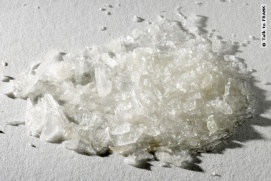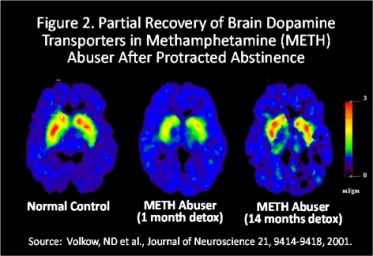Methamphetamine Abuse: Difference between revisions
No edit summary |
No edit summary |
||
| Line 30: | Line 30: | ||
Meth abusers can present with a variety of physical characteristics which can include the following: | Meth abusers can present with a variety of physical characteristics which can include the following: | ||
<br>- Increased heart rate, blood pressure, respiration, temperature<br>- Excessive sweating<br>- Dry skin with multiple scabs or open wounds on the face or arms<br>- Scratching or “picking” skin<br>- Track marks on arms or other parts of the body<br>- Rapid speech <br>- Anxiety<br>- Irritability<br>- Insomnia<ref name="Mayo">Mayo Clinic. Drug Addiction. http://www.mayoclinic.com/health/drug-addiction/DS00183/DSECTION=symptoms (accessed 26 March 2012)</ref> | <br>- Increased heart rate, blood pressure, respiration, body temperature<br>- Excessive sweating<br>- Dry skin with multiple scabs or open wounds on the face or arms<br>- Scratching or “picking” skin<br>- Track marks on arms or other parts of the body<br>- Rapid speech <br>- Anxiety<br>- Irritability<br>- Insomnia<ref name="Mayo">Mayo Clinic. Drug Addiction. http://www.mayoclinic.com/health/drug-addiction/DS00183/DSECTION=symptoms (accessed 26 March 2012)</ref> | ||
<br>More chronic meth users can also present with the following: | <br>More chronic meth users can also present with the following: | ||
Revision as of 23:24, 1 April 2012
Original Editors - Seth Pinkerton & Jessica Sparks from Bellarmine University's Pathophysiology of Complex Patient Problems project.
Lead Editors - Your name will be added here if you are a lead editor on this page. Read more.
Definition/Description[edit | edit source]
Methamphetamine is a central nervous system stimulant similar to the drug amphetamine and is classified as a Schedule II drug due to its high potential for abuse. It affects the brain by increasing the release and blocking the reuptake of dopamine which is a common mechanism of action for most drugs that are abused.[1]
Dopamine is a neurotransmitter responsible for the reward, motivation, and pleasure centers of the brain. Methamphetamine causes a rapid release of dopamine in the brain resulting in an intense euphoric or grandeur feeling which is the addictive property of the drug.[1]
Methamphetamine is a white, odorless, bitter tasting crystalline powder which can easily be dissolved in water or other liquids. It is taken orally, intranasally (snorting), by smoking, or intravenously.[1]
Meth can be made from common household substances including:
Pseudoephedrine - decongestant
iodine crystals
battery acid
red phosphorus – match boxes and road flares
anhydrous ammonia – fertilizer or countertop cleaner
toluene – brake fluid
hydrochloric acid
acetone – nail polish remover or paint thinner
sodium hydroxide - lye
sulfuric acid – drain or toilet bowl cleaner[3]
Street names include meth, speed, ice, glass, chalk, and many others.[1]
Prevalence[edit | edit source]
add text here
Characteristics/Clinical Presentation[edit | edit source]
Meth abusers can present with a variety of physical characteristics which can include the following:
- Increased heart rate, blood pressure, respiration, body temperature
- Excessive sweating
- Dry skin with multiple scabs or open wounds on the face or arms
- Scratching or “picking” skin
- Track marks on arms or other parts of the body
- Rapid speech
- Anxiety
- Irritability
- Insomnia[4]
More chronic meth users can also present with the following:
- Anorexic appearance (extreme weight loss)
- “Meth mouth” – severe tooth loss/decay
- Confusion
- Hallucinations
- Paranoia
- Delusions of feeling bugs crawling under skin (which leads to excessive scratching and open wounds)
- Delusions of grandeur
- Violent behavior[4]
Associated Co-morbidities[edit | edit source]
add text here
Medications[edit | edit source]
There is no one drug that is used to cure methamphetamine addiction but this list offers help to those individuals who are in the process of recovering:
- Bupropion (Wellbutrin) - used to treat depression and cravings
- Topiramate (Topamax) –used to treat cravings and seizures that can occur during withdrawal
- Modafinil – non-amphetamine stimulant shown to improve cognitive functioning[5]
These drugs along with psychological treatment at a drug/rehab facility offer the best hope for the addict to have a successful recovery.[5]
Diagnostic Tests/Lab Tests/Lab Values[edit | edit source]
add text here
Etiology/Causes[edit | edit source]
There is not one known cause of methamphetamine abuse but it is thought that the following can lead someone to try meth and subsequently become addicted:
- Genetic predisposition (if a parent has an addiction problem it is thought that the child will be more likely to have an addiction problem as well)
- Risk seeking personality
- Peer pressure
- Low self-esteem
- Anxiety
- Loneliness or Depression
- Ease to make
Systemic Involvement[edit | edit source]
add text here
Medical Management (current best evidence)[edit | edit source]
The most effective treatments being used today to treat methamphetamine abuse or addiction involves cognitive and behavioral interventions. Trained psychotherapists who specialize in the area of drug addiction are the preferred medical professionals to carry out these interventions.[6]
Initially the meth abuser needs to attend a detox center with trained medical staff to be assessed and treated for physical and psychological complications that can occur as the person’s body is going through withdrawal from the drug.[6]
Cognitive and Behavioral interventions used to treat meth abuse:
- Cognitive Behavioral Therapy (CBT): is based on the idea that thoughts and feelings cause our behaviors, not external factors such as people, situations, and events. This type of therapy aims to help the addict change the way they think and behave to increase coping skills with the stresses of life.[7]
- The Matrix Model: includes intensive individual and group therapy to promote behavioral changes needed to prevent relapse, be abstinent, and establish a lifestyle unrelated to drugs. This can include changing their where they live, the people they associate with, and even their profession.[7]
- Motivational Incentives for Enhancing Drug Abuse Recovery (MIEDAR): an incentive based treatment promoting meth abstinence is another treatment that has shown efficacy in meth abuser through the National Drug Abuse Clinical Trials Network.[6]
Medications such as Wellbutrin are used in conjunction with therapy to treat depression which many recovering addicts suffer from along with the willingness to change can lead to successful recovery.
Physical Therapy Management (current best evidence)[edit | edit source]
add text here
Alternative/Holistic Management (current best evidence)[edit | edit source]
add text here
Differential Diagnosis[edit | edit source]
add text here
Case Reports/ Case Studies[edit | edit source]
add links to case studies here (case studies should be added on new pages using the case study template)
Resources
[edit | edit source]
Centers for Disease Control and Prevention (CDC): Methamphetamine
Click here to find publicly funded treatment facilities in the USA by state
Recent Related Research (from Pubmed)[edit | edit source]
see tutorial on Adding PubMed Feed
Failed to load RSS feed from http://eutils.ncbi.nlm.nih.gov/entrez/eutils/erss.cgi?rss_guid=1NGmwZeh8JwVIzrKgHG1LrDm0izTr7ViJiDkSYAY2BW5hiXsx0|charset=UTF-8|short|max=10: Error parsing XML for RSS
References[edit | edit source]
see adding references tutorial.
- ↑ 1.0 1.1 1.2 1.3 National Institute on Drug Abuse. http://www.drugabuse.gov/publications/infofacts/methamphetamine. (accessed 25 March 2012)
- ↑ Addiction Treatment Centers. Methamphetamine. http://www.addictiontreatmentcenters.net/about-the-drugs/methamphetamine (accessed 1 April 2012)
- ↑ Meth Project. What's in Meth. http://www.methproject.org/answers/whats-meth-made-of.html?gclid=CI3C--m7j68CFYMKKgodIkCUyQ#Whats-in-Meth (accessed 25 March 2012)
- ↑ 4.0 4.1 Mayo Clinic. Drug Addiction. http://www.mayoclinic.com/health/drug-addiction/DS00183/DSECTION=symptoms (accessed 26 March 2012)
- ↑ 5.0 5.1 Galanter M, Kleber H. The American Psychiatric Publishing Textbook of Substance Abuse Treatment. Fourth edition. Virginia: American Psychiatric Publishing, Inc., 2008. p169-176.
- ↑ 6.0 6.1 6.2 6.3 National Institute on Drug Abuse. Topics in Brief: Methamphetamine Addiction: Progress, but Need to Remain Vigilant. http://www.drugabuse.gov/publications/topics-in-brief/methamphetamine-addiction-progress-need-to-remain-vigilant (accessed 1 April 2012)
- ↑ 7.0 7.1 Rawson R, Casey P, Dickow A, Frazier Y, Gallagher C, Galloway G, et al. A multi-site comparison of psychosocial approaches for the treatment of methamphetamine dependence. Addiction 2004; 99: 6. p708-717.








